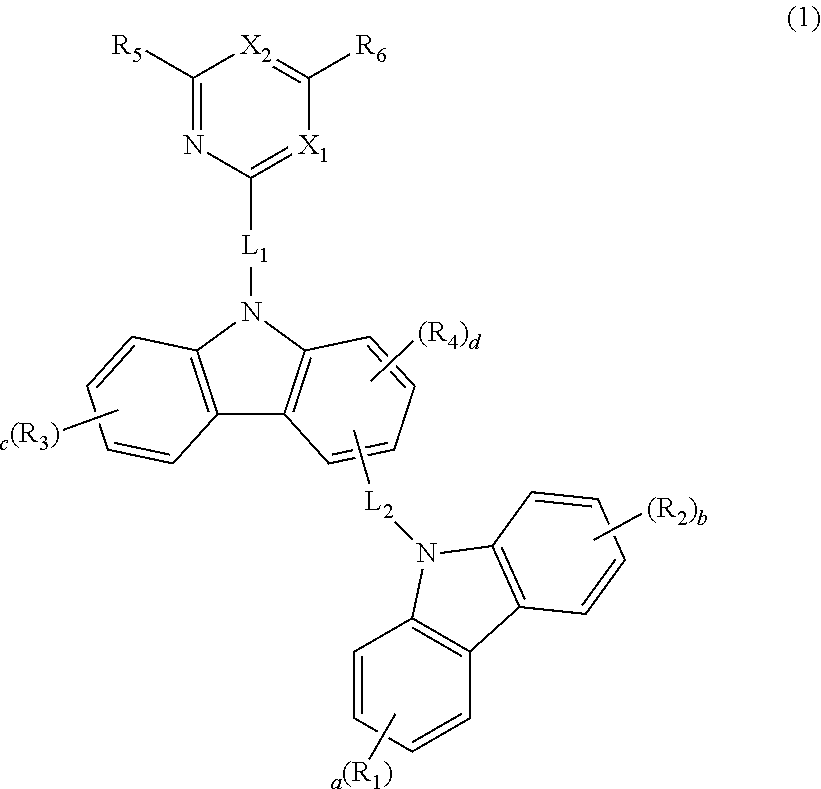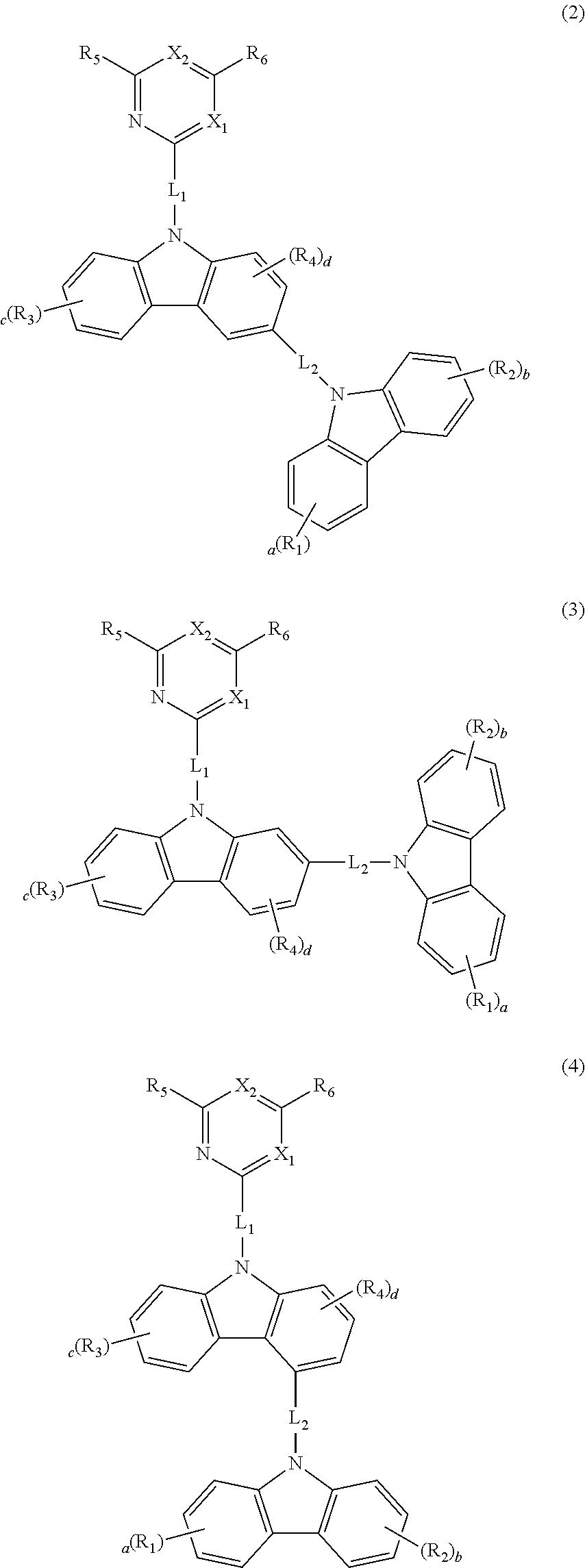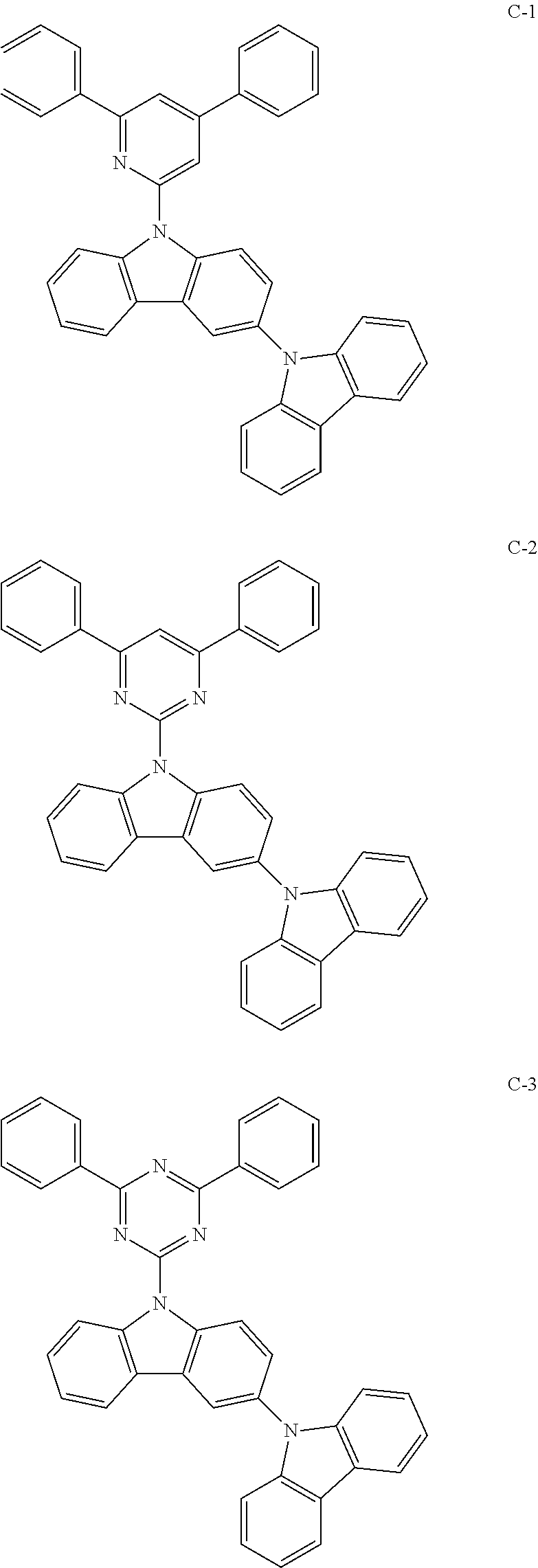Novel organic electroluminescence compounds and organic electroluminescence device containing the same
- Summary
- Abstract
- Description
- Claims
- Application Information
AI Technical Summary
Benefits of technology
Problems solved by technology
Method used
Image
Examples
example 4
EXAMPLE 4
Preparation of Compound C-53
[0096]
Preparation of Compound C-4-1
[0097]After mixing 9H-carbazole (20 g, 119.6 mmol), 1-bromo-4-iodobenzene (68 g, 240.3 mmol), CuI (11.4 g, 59.8 mmol), ethylenediamine (8 mL, 119.6 mmol), K3PO4 (50.88 g, 240 mmol), and toluene 200 mL in a 500 mL round-bottom flask; the mixture was stirred for 5 hours under reflux. After the reaction was completed, the mixture was cooled to room temperature; extracted with dichloromethane (DCM) and H2O; and the DCM layer was dried with MgSO4. Then, the DCM layer was concentrated under reduced pressure, and filtered through silica gel with a column. Then, the obtained solvent was concentrated under reduced pressure to obtain compound C-4-1 (33.8 g, 85%).
Preparation of Compound C-4-2
[0098]After mixing compound C-4-1 (10 g, 31.0 mmol), and THF 150 mL in a 500 mL round-bottom flask; the mixture was cooled to −78° C. Then, 2.5 M n-butyl lithium (14.8 mL, 37.2 mmol) was added to the mixture, and after 1 hour, isopro...
example 5
Preparation of Compound C-54
[0102]
Preparation of Compound C-5-1
[0103]After mixing 9H-carbazole (60 g, 350.8 mmol), 1-bromo-3-iodobenzene (202 g, 717.6 mmol), CuI (33.4 g, 175.4 mmol), ethylenediamine (23 mL, 350.8 mmol), K3PO4 (152.1 g, 717.6 mmol), and toluene 400 mL in a 1 L round-bottom flask, the mixture was stirred for 23 hours under reflux. After the reaction was completed, the mixture was cooled to room temperature; extracted with DCM and H2O; and the DCM layer was dried with MgSO4. Then, the DCM layer was concentrated under reduced pressure, and filtered through silica gel with a column. Then, the obtained solvent was concentrated under reduced pressure to obtain compound C-5-1 (68 g, 61%).
Preparation of Compound C-5-2
[0104]After mixing compound C-5-1 (10 g, 31.0 mmol), and THF 150 mL in a 500 mL round-bottom flask, the mixture was cooled to −78° C. Then, 2.5 M n-butyl lithium (14.8 mL, 37.2 mmol) was added to the mixture, and after 1 hour, isopropyl borate (10.73 mL, 46.5...
example 1
Device Example 1
Production of an OLED Device Using the Compound According to the Present Invention
[0107]An OLED device was produced using the compound according to the present invention. A transparent electrode indium tin oxide (ITO) thin film (15 Ω / sq) on a glass substrate for an organic light-emitting diode (OLED) device (Samsung Corning, Republic of Korea) was subjected to an ultrasonic washing with trichloroethylene, acetone, ethanol and distilled water, sequentially, and then was stored in isopropanol. Then, the ITO substrate was mounted on a substrate holder of a vacuum vapor depositing apparatus. N1,N1′-([1,1′-biphenyl]-4,4′-diyl)bis(N1-(naphthalen-1-yl)-N4,N4-diphenylbenzen-1,4-diamine) was introduced into a cell of said vacuum vapor depositing apparatus, and then the pressure in the chamber of said apparatus was controlled to 10−6 torr. Thereafter, an electric current was applied to the cell to evaporate the above introduced material, thereby forming a hole injection layer ...
PUM
 Login to View More
Login to View More Abstract
Description
Claims
Application Information
 Login to View More
Login to View More - R&D Engineer
- R&D Manager
- IP Professional
- Industry Leading Data Capabilities
- Powerful AI technology
- Patent DNA Extraction
Browse by: Latest US Patents, China's latest patents, Technical Efficacy Thesaurus, Application Domain, Technology Topic, Popular Technical Reports.
© 2024 PatSnap. All rights reserved.Legal|Privacy policy|Modern Slavery Act Transparency Statement|Sitemap|About US| Contact US: help@patsnap.com










